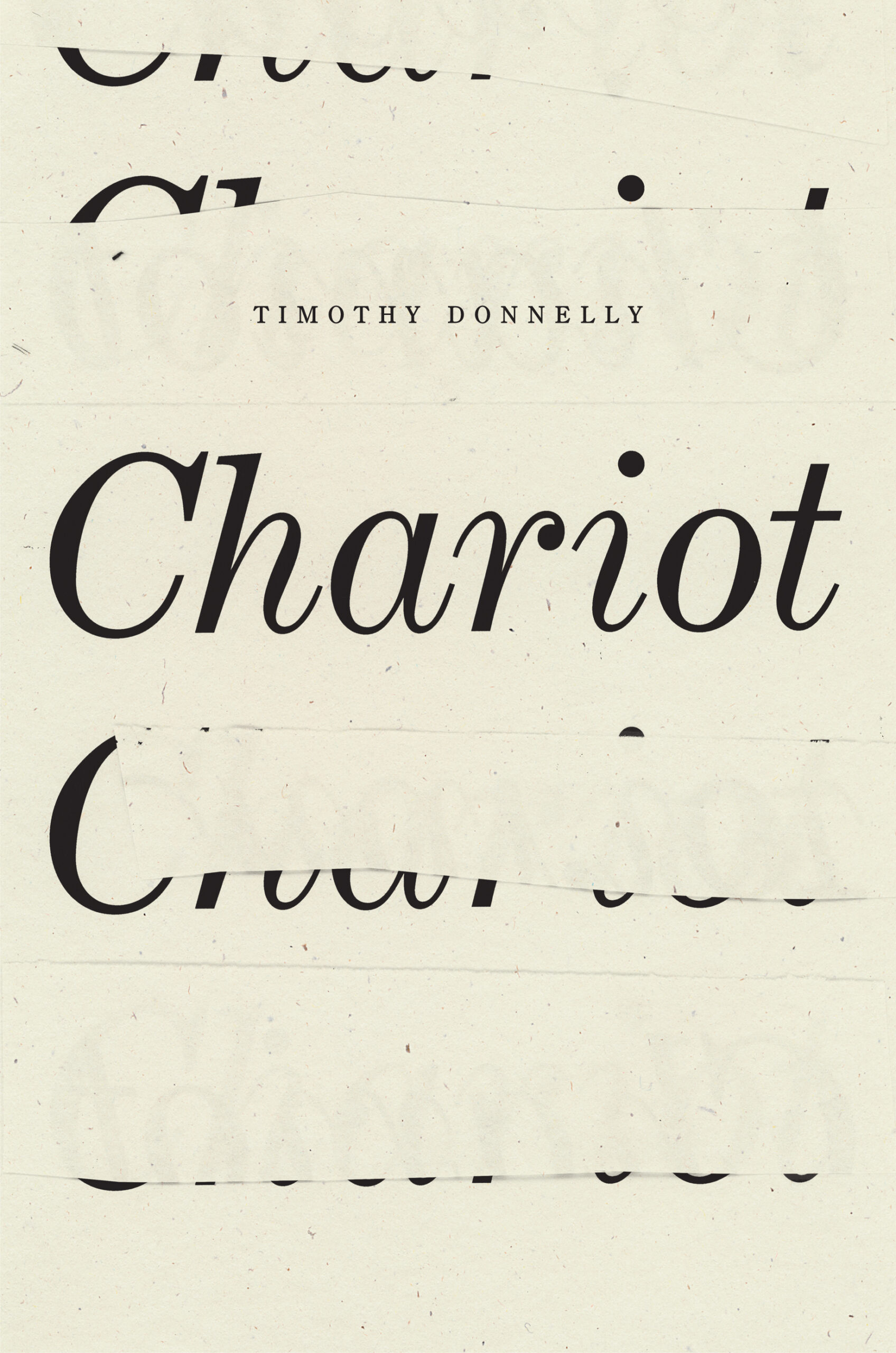What would happen if a poem “talked” to its reader? What would the “voice” of this poem sound like? These are the questions that Timothy Donnelly begs in “This Is the Assemblage,” the final poem of his fourth, and most recent collection Chariot, a poem that Donnelly, in one of his rapturous Instagram posts, refers to as “the voice of the book itself saying/not saying goodbye to me as it heads off into the distance/goes nowhere but that seems to me more than a little too self-serious for comfort. Mostly it’s just a poem, lying flat on the page, asking me to remember it. And I do.” What interests me about Donnelly’s own commentary on the poem is how it accurately diagnoses the split subject of the lyric poet as someone who must see their language as “vital” or alive, with the capacity to “say,” or to “head off into the distance,” while simultaneously understanding that the poem, in fact, “goes nowhere,” and is simply “a poem” lying flat on a piece of paper.
This dichotomy strikes me as particularly relevant, considering contemporary discussions circling the literary device of “apostrophe,” a device that could be broadly used to denote the work of Donnelly’s poem’s direct address to its reader (or writer). Whether one considers Barbara Johnson’s definition of apostrophe as a kind of puppetry, where a speaker “throws voice… into the addressee, turning its silence into a mute responsiveness,” or Jonathan Culler’s assertion that apostrophe is lyric poetry’s most “embarrassing” rhetorical feature because of how it takes “absent, dead, or inanimate entities” and makes them “present, vital, and humanlike,” one can sense that there is some discomfort with how apostrophe intentionally confuses the categories of the animate and the inanimate, the “real” lyric poet and the “artificial” addressee of the poem. Yet, statements such as Culler’s or Johnson’s are predicated on the assumption that the “voice” of the lyric poet is “real” to begin with, revealing their inherent bias towards entities that they deem as “inanimate.” Donnelly’s poem, in its flipping of the typical apostrophic construction, so that the “inanimate” entity of the poem addresses the “present and humanlike” reader, is committed to displaying language’s inherent vitality as “more than furniture, more than vehicle with wheels or wings,” highlighting the belief expressed in Jane Bennett’s book Vibrant Matter that “human being and thing-hood overlap… the us and the it slip-slide into each other.”
At this point, you might be wondering why I am writing this essay under Poetry Daily’s Ecopoetry Now banner. To me, the methods by which Donnelly’s work portrays the overlapping nature of human being and thing-hood is absolutely essential in this era where we are reaping the rampant consequences of anthropogenic climate change while simultaneously witnessing the rise of global conservative movements campaigning on the refusal of any and all culpability for it. It is of dire importance that lyric poetry decenter the “human” as that which can only be “present and vital” and that we recognize that the human is merely “an assemblage of assemblages,” as Donnelly and Bennett do, highlighting that we are a “confederations of tools, microbes, minerals, sounds, and other “foreign” materialities.”
What Culler and Johnson denote as ventriloquizing and “embarrassing” about apostrophe is how it points to the animacy of the inanimate, an animacy that unsettles some of the key technologies that center the human and place “nature” always at a distance. In their seminal book Ecology Without Nature: Rethinking Environmental Aesthetics, Timothy Morton refers to these technologies by the term “ecomimesis,” a term they define as “a specific rhetoric that generates a fantasy of nature as a surrounding atmosphere, palpable but shapeless.” For Morton, “ecomimesis” is unavoidable—it is central to establishing the “here and now” that marks every piece of writing. Yet, ecomimesis also always fails to deliver an accurate portrait of “the slip-slide of the us and the it’ because of the “inherent instability of language, and of the human and nonhuman worlds.” There is always a distance in the lyric act. Yet for Morton it is essential that we “deal with the idea of distance itself. If we try to get rid of distance too fast, in our rush to join the nonhuman, we will end up caught in our prejudice, our concept of distance, our concept of ‘them.’ Hanging out in the distance may be the surest way of relating to the nonhuman.” Donnelly points to this distance when his “assemblage” tries to articulate its own positionality: “we are not worthless/here, but cradled in a hold the escape from which is ever-imminent/even after it happens, even when we stand for nothing in particular/other than the motion of it.” The words themselves, after being deployed in a poem to encapsulate a meaning they can only approach, merely represent that approach, that attempt at meaning or mimetic portraiture, an attempt that nonetheless creates a kind of energy, a “motion.”
It is no surprise to me that Donnelly’s career-long dissection of ecological aesthetics reaches its fever pitch in Chariot. Following on the tail of three books whose poems could be expected to expand capaciously over entire clutches of pages, all of the poems in Chariot share the same form: five shapely quatrains that recall Keats in their stepped indentations. Donnelly’s work has always been in conversation with Keats, but it is here, through Chariot’s strictness of form, that Donnelly broaches on what Keats called the “egotistical sublime,” the notion that there is a direct correlation between “voice” and environment. Form molds and directs the thinking in these poems, “This Is the Assemblage” included. Yet form also becomes a stricture to push against in these poems, further articulating the question asked by Whitman that Donnelly enlists as the book’s epigraph: “to be in any form, what is that?”
As opposed to using form to create a container for mimetic experience, form is implemented here to highlight how language innately exceeds its container, as Donnelly insists at the end of one of the book’s two title poems: “and yet, moving forward, if another sentence/follows on the heels, as this one does, I say that when it ends, its ending will/unleash lions.” This emancipatory “end of the sentence,” carries over into “This Is the Assemblage.” As the poem approaches its ending, the assemblage reminds the reader to “remember/we’ll always be here at the bottom of it, over. All we have is life.” The exact contours of the “life” that is mentioned here are purposefully left vague. I like to think that I hear a touch of Henri Bergson’s “élan vital,” what he defined as “the primitive impetus of the whole,” an energy that, in Jane Bennett’s words “‘splays’ itself out in new forms that are not even conceivable before they exist, and were they to be quantified and measured, it would already be too late, for life will have moved on.”




